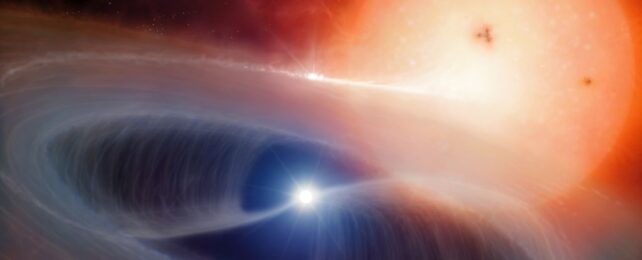One of the great mysteries of the Universe is where all the metal actually comes from.
We know it's forged in cosmic fire – but which fires in particular, and in which proportions, is a little bit more difficult to pin down.
A rare kind of supernova devoid of hydrogen and helium is a known source of many metals, though whether the stars that give rise to these firey forges are solitary heavyweights that sneezed their coats off or smaller masses with a greedy partner has never been clear.
Now an international team of astronomers led by Martín Solar and Michał Michałowski of the Adam Mickiewicz University in Poland has found the progenitors of Type Ic supernovae aren't all hugely massive lone wolves, but typically less massive stars with a binary companion that helps shape the output of their fated explosion.
"The more we investigate the massive stars the more complex they appear," Michałowski told ScienceAlert.
"We know that their evolution and fate depends on their mass, then we learned that the details depend on how much they are enriched in metals. Now it gets obvious that companions can also greatly influence their lives."
Type Ic supernovae are caused by the core collapse of massive stars that have reached the end of their lifespan. All the hydrogen in the stellar core has been fused into heavier elements, and the star has reached a point where its core elements are so heavy that they take more energy to fuse than the fusion process releases.
With the nuclear furnace no longer releasing sufficient energy, outward pressure drops, allowing the star's dense core to succumb to gravity. The core violently collapses into an ultra-dense neutron star or black hole while the outer layers blast out into space so energetically, even heavier metals are forged in the ejecta.
The mystery with Type Ic supernovae is that unlike other supernovae, there is no detectable hydrogen or helium in their expanding outer shell. Though depleted in the stellar core, the lighter elements should have remained in the atmosphere in sufficient quantities.
Two possible solutions to the mystery of the missing elements have been suggested. The first involves a star around 20 to 30 times the mass of the Sun, one so massive it would produce strong stellar winds capable of blowing away its hydrogen and helium.
The second option is a binary companion – a smaller star that is close enough to siphon off the hydrogen and helium from a star between around 8 and 15 times the mass of the Sun.
In both cases, the hydrogen and helium are whisked away before the supernova explosion, resulting in their absence in the supernova ejecta.
There are several types of core collapse supernovae. By looking at archival data and finding stars that have disappeared from a supernova's location, researchers have been able to confirm the progenitors of just 23 of the observed events.
None of those progenitors are from Type Ic supernovae, but Michałowski and his team thought their environments might have left some clues.
"I got inspired by a large observing program called PHANGS (Physics at High Angular resolution in Nearby GalaxieS). They used the largest telescope array, Atacama Large Millimeter Array, to observe individual clouds of gas from which stars form," he explained.
"I figured out that if I complement these data with new observations of clouds in which supernovae exploded, then we can decipher the nature of the exploding stars."
The molecular gas left behind at the sites of supernovae can be used to determine how massive the progenitor star was. The more molecular hydrogen, the more massive the star. In turn, more massive stars fuse fuel faster and therefore have shorter lifespans than less massive ones.
The researchers looked at the molecular gas left behind by Type Ic supernovae, and compared it to the molecular gas left behind by Type II supernovae, which have progenitor stars between 8 and 15 solar masses. The hydrogen in both clouds was the same – which means Type Ic supernovae are from less massive stars after all.
"I actually expected progenitors of Type Ic supernovae to turn up to be very massive stars," Michałowski said. "It turned out that most of these supernovae do not behave in this way."
The hydrogen and helium still have to go somewhere; and the most likely place is a binary companion. This companion usually survives the supernova, Michałowski explained, but the force of the explosion punts the companion across space, where it lives the rest of its lifespan fairly normally, if at a different velocity.
Meanwhile, the explanation helps us understand where many elements in the Universe come from. We know that supernova explosions involving a binary companion produce twice the amount of carbon – a building block of life – so now we can adjust the contribution of Type Ic supernovae to the amount of carbon out there.
The researchers also hope to perform their astroforensics on the remains of even more supernovae, to help reconstruct how the progenitor stars lived their lives.
"A larger number of supernovae with such observations will push this analysis further, because then we will be able to investigate them separately with respect to some other interesting properties," Michałowski told ScienceAlert.
"For example we don't know whether the existence of broad emission lines tells us something about the exploding star. Or whether some properties of host galaxies influence what stars are born or how they explode. Moreover, we would like to investigate other supernovae types in this way."
The research has been published in Nature Communications.
